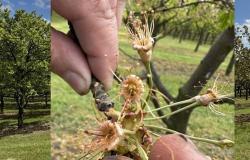According to experts, the course of winter can foreshadow how “fresh” the rest of the year will be. Although this year there was less snow than usual and its reserves largely melted with the warming at the turn of the year, everything was saved by above average rainfall.
Hydrologist Vladimír Šala from the Czech Hydrometeorological Institute (ČHMÚ) sees this winter as the richest in precipitation since 1961, and experts from the Institute of Global Change Research of the Academy of Sciences of the Czech Republic (abbreviated as CzechGlobe) also agree.
“From the point of view of rainfall, the winter was one of the record ones. On average, it fell sixty percent more than usual for the entire republic, and the Olomouc region was no exception. So what was missing in snow was replaced by a significantly larger amount of rain,” said climatologist Pavel Zahradníček from CzechGlobe.
According to him, it was the rains that helped ensure that the soil is currently sufficiently saturated with water not only in the surface layer, but also in depth. For example, at this time last year, the situation was significantly worse, and the latest analyzes by experts from the Intersucho.cz project even showed that even in 2019, sixty liters of water were missing for every square meter in the south and southwest of the region.
Scientists evaluate the degree of drought based on a comparison of the current situation with the average amount of water in the soil between 1961 and 2010.
“If we look at this year’s soil moisture values in the region from a long-term perspective, they correspond to the average of the mentioned period. In the layer up to 40 centimeters, it is slightly lower than usual in places, on the contrary, at depths of 40 to 100 centimeters it is slightly higher or average,” explained Zahradníček.
Rivers are above normal
The saturation of the deeper soil layers is a good sign, he says, because it reflects the long-term condition.
“It’s definitely an improvement. However, the question is how long it will last. It always depends on the weather,” emphasized the climatologist.
Hydrologists are also satisfied with the current situation. “The situation in Upper Moravia is extremely abnormal, the groundwater is saturated. We’ll see how it develops,” Šala assessed.
Up to ten centimeters of snow fell in JeseníkyWhile the trees are blooming in lower elevations, winter returned to Jeseníky over the weekend and a layer of new snow fell on the mountain tops. The return of winter weather has improved the conditions in the Ovčárn ski resort, the only Jesenice ski resort where skiing is still available. “About ten centimeters fell on Praděda,” described the dispatcher of the mountain service on Sunday. A ski resort is still in operation right next to the highest Moravian-Silesian mountain, which is the highest ski resort in the Czech Republic – on the northern slopes of Petrový kamené, you can ski at an altitude of 1,235 to 1,445 meters above sea level. In the highest parts of the mountains, cross-country skiers can also continue to use the modified track from Ovčárna to Praděd. “We are planning an Easter egg ski race on March 31, and we have decided to expand the categories for everyone, not just small children. So anyone can come and race. If it works and people are interested, we expect that we will continue to be in operation,” outlined the representative of the center, Renata Figurová. (ČTK) |
There was also more water flowing in the rivers than usual in winter. At the end of last year and the beginning of this year, water managers even dealt with flood flows.
“The entire winter was spent in a very high saturation of the entire basin. This could also be seen in the watercourses, which were able to activate relatively quickly in the event of precipitation and in some places even exceeded the average values by several times,” said Povodí Moravy spokesman Petr Chmelař.
Drought may still come this year
Climatologists are very satisfied with the rainfall in the region for the time being. According to them, if the current course of the weather lasts, this year could be a turning point in view of the long-term deepening drought.
“Of course, it’s too early to predict what the summer will be like. However, we assume that the spring will have good precipitation until May and slightly above average temperatures, at the same time the temperatures will not be extreme, so we do not expect a lot of water evaporation. The water saturation of the soil should therefore be maintained, at least during the start of the growing season,” predicted Pavel Lipina, climatologist of the ČHMÚ.
According to experts from CzechGlobe, even a favorable start to spring does not necessarily mean that the region will avoid drought completely. It will depend on the length of the period with high temperatures that dry the soil the most. Summer heat waves are thus a risk factor.
“In the very dry years of 2015 to 2019, high temperatures were added to the lack of precipitation and caused an intense and long drought,” reminded climatologist Zahradníček.
According to him, soil drought occurs every year and nature is prepared for it. However, the decisive factor is how long it lasts, how intense it is and in which part of the year it strikes.
“Thus, if there is a sub-normal spring in terms of precipitation and above-average temperatures, there will be a risk of a dry episode this year as well,” warned the scientist.
Fear of night frosts again
Climatologists also warn that the frosts that hit the region this week may strike again.
“It cannot be ruled out that, for example, in April we will still get snow in the lower elevations. It only happens once every five years, but it happens,” Lipina pointed out. Among other things, orchardists, especially apricot growers, who already have trees in full bloom, are watching the weather forecasts with concern.
In a number of places in the Olomouc region, including apricot orchards, the trees are already blooming (picture from the orchards in Skrbni in Olomouc).
“This year, the weather is not in our favor at all, the vegetation is about three weeks faster and our orchards are in full bloom. The frost can deprive us of the harvest,” worries Marcel Špaček from the Solagro company, who grows apricots on three and a half hectares near Skrbně in Olomouc.
The fact that February was extremely warm and the earliest varieties of apricots bloomed earlier is also confirmed by Tomáš Nečas, head of the Institute of Fruit Growing at Brno’s Mendel University. How the current April weather will affect growers will depend on a number of factors.
“Two- to three-degree frosts for two days are borderline conditions for apricots. Strength and duration will be decisive,” he summarized. “Unfortunately, it cannot be ruled out that in some locations this could have catastrophic consequences and mean a total loss of crops,” he admitted.
Growers can protect their orchards, if it is economically viable, by spraying, misting, or they can be heated with beams and special candles.
For example, according to the growers, people do not have to worry about the very popular self-picking of strawberries, which are not missed by crowds of interested people every year. “The strawberry trees are not in bloom yet, they will not be affected by the frost,” said Špaček, a grower from Skarpen.
Tags: region replenished water supplies rainy winter long uncertain
-





